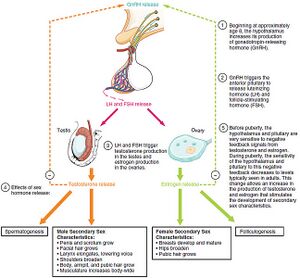Physiological Changes in Girls During Puberty
Original Editor - User Name
Top Contributors - Khloud Shreif and Kirenga Bamurange Liliane
Introduction[edit | edit source]
Puberty is a normal, vital, physiological process including a series of normal hormonal changes resulting in changes in gonads (testosterone, aldosterone, and progesterone) and reproductive organs to be functionally mature, resulting in the physical development of sexually mature adults, it is a transition stage between the childhood and adulthood period happens in all normal individuals. This process undergoes different factors; hormonal, genetic, environmental, or even nutritional factors. This period that begins at puberty and ends in early adulthood is named adolescence, ages between 10- 19 as defined by WHO[1].
Age Of Puberty[edit | edit source]
There is a decrease in the age of puberty in the last century, the age of thelarche (breast development) has been decreased by 3 months per decade since 1977[2], age of menarche was observed to be reduced in US and EUROPE in the last century. This may be undergoing environmental, social, endocrine-disrupting, obesity, or genetic factors[3].
Higher BMI before puberty onset was associated with early menarche in females, obese children have a higher serum leptin levels and leptin can accelerate the onset of puberty, while in overweight boys there is not confirmed yet if it is associated with early or delayed puberty[4].
In African America, it begins around the age of 6, and in white girls starts between 8 and 13 years of age. It is considered the spurt of puberty that occurs between 9 and 10 years old.
Physiology Of Puberty[edit | edit source]
The first changes of puberty are initiated by pulsatile secretion of Gonadotropin-Releasing Hormone (GnRH) neurons of the hypothalamus. GnRH is transported to the anterior pituitary gland (pituitary gonadotropes) resulting in the synthesis and release of LH and FSH from the gonadotropic cells of the anterior pituitary gland these hormones affect theca and granulosa cells of the ovary in females and affect the Leydig and Sertoli cells in the testes. This is considered the spurt of physical puberty in individuals[5]. The level of circulating LH is much greater than FSH in boys and girls from early pre-puberty to pubertal onset[6].
Then when LH and FSH bind to their receptors in ovaries and testes they stimulate them to release (estrogen, aldosterone, and a small amount of testosterone in females). FSH increases estrogen production from the ovaries, and LH helps to start the ovulation and creation of the corpus luteum in girls. While in boys FSH triggers testicular growth and supports spermatozoa maturation, and LH increases testosterone production[7].
Secretion of Growth Hormone (GH) from the pituitary gland helps to keep the linear progress of puberty[8].
Phases of Adolescence[edit | edit source]
Early phase (11–13 years): age of middle school the children start to grow more quickly, it is characterized by puberty and sexual development
Middle adolescence (14–18 years): age of the high school, the puberty continues but changes are less common than the easrly phase.
Late adolescence (19–21 years): age of post high school graduation or college
Physiological Signs and Symptoms[edit | edit source]
Physiological changes
- Breast development (thelarche ), the first and most notable sign, it occurs with a mean age of 10 years.
- Enlargement of the labia majora and labia minora.
- Clear to white vaginal discharge.
- Pubic hair, and axillary hair development.
- Acne
- Menarch (first menstrual cycle ), begins about 2.5 years after thelarche and can range from 9 to 15 years old[9].
- Growth spurt.
Psychological, emotional, and social changes
Pathophysiology[edit | edit source]
Premature puberty: it starts before the age of 7 or 8 in girls, and before 9 in boys.
Delayed puberty
It is a lack of physical signs of puberty about 2 to 2.5, in boys it can reach to be about 4 years. In girls, the absence of breast development by 13 years or more than 4 years between (thelarche ) and menarche is considered delayed puberty.
Resources[edit | edit source]
References[edit | edit source]
- ↑ Das JK, Salam RA, Thornburg KL, Prentice AM, Campisi S, Lassi ZS, Koletzko B, Bhutta ZA. Nutrition in adolescents: physiology, metabolism, and nutritional needs. Annals of the New York Academy of Sciences. 2017 Apr;1393(1):21-33.
- ↑ Eckert-Lind C, Busch AS, Petersen JH, Biro FM, Butler G, Bräuner EV, Juul A. Worldwide secular trends in age at pubertal onset assessed by breast development among girls: a systematic review and meta-analysis. JAMA pediatrics. 2020 Apr 1;174(4):e195881-.
- ↑ Brix N, Ernst A, Lauridsen LL, Parner E, Støvring H, Olsen J, Henriksen TB, Ramlau‐Hansen CH. Timing of puberty in boys and girls: A population‐based study. Paediatric and perinatal epidemiology. 2019 Jan;33(1):70-8
- ↑ Wang Y. Is obesity associated with early sexual maturation? A comparison of the association in American boys versus girls. Pediatrics. 2002 Nov 1;110(5):903-10.
- ↑ Herbison AE. Control of puberty onset and fertility by gonadotropin-releasing hormone neurons. Nat Rev Endocrinol. 2016 Aug;12(8):452-66.
- ↑ Mitamura R, Yano K, Suzuki N, Ito Y, Makita Y, Okuno A. Diurnal rhythms of luteinizing hormone, follicle-stimulating hormone, testosterone, and estradiol secretion before the onset of female puberty in short children. The Journal of Clinical Endocrinology & Metabolism. 2000 Mar 1;85(3):1074-80.
- ↑ Alotaibi MF. Physiology of puberty in boys and girls and pathological disorders affecting its onset. Journal of adolescence. 2019 Feb 1;71:63-71.
- ↑ Robson H, Siebler T, Shalet SM, Williams GR. Interactions between GH, IGF-I, glucocorticoids, and thyroid hormones during skeletal growth. Pediatric research. 2002 Aug;52(2):137-47.
- ↑ Sørensen S, Brix N, Ernst A, Lauridsen LL, Ramlau-Hansen CH. Maternal age at menarche and pubertal development in sons and daughters: a Nationwide Cohort Study. Human Reproduction. 2018 Nov 1;33(11):2043-50.







